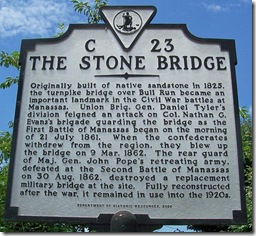 Fairfax County, VA
Fairfax County, VA
Marker No. C-23
Marker Text: Originally built of native sandstone in 1825, the turnpike bridge over Bull Run became an important landmark in the Civil War battles at Manassas. Union Brig. Gen. Daniel Tyler's division feigned an attack on Col. Nathan G. Evans's brigade guarding the bridge as the First Battle of Manassas began on the morning of 21 July 1861. When the confederates withdrew from the region, they blew up the bridge on 9 Mar. 1862. The rear guard of Maj. Gen. John Pope's retreating army, defeated at the Second Battle of Manassas on 30 Aug. 1862, destroyed a replacement military bridge at the site. Fully reconstructed after the war, it remained in use into the 1920s.
Location: West of Centreville, VA, on U.S. Route 29 (Lee Highway) west of County Route 609 (Bull Run Post Office Road), on the north side of the road. Grouped with marker Z-169 (Fairfax/Prince William County). Erected by the Department of Historic Resources in 2000.
Photo taken on Route 29 looking west toward the Stone Bridge at the Prince William/Fairfax County line.
This marker is actually 0.4 miles east of the Stone Bridge and is in Fairfax County and the bridge is in Prince William County. Makes one wonder why they did not place it closer to the bridge. The first shots on the morning of July 21, 1861 occurred at this bridge. With the Union troops on the east of the bridge and the Confederates on the west side. Though one can imagine Brigadier General Daniel Tyler's division marching past this point along the road on their way to the Stone Bridge. Tyler's troops were to give the Confederate troops the impression that the Union forces were going to force a crossing here at the Stone Bridge.
The Stone Bridge crosses the stream called Bull Run, just a few miles north of the Manassas junction. Bull Run with banks too steep to ford just anywhere, it was crossable only at a stone bridge on the road to Warrenton and at a handful of fords. (A ford is a shallow place with good footing where a river or stream may be crossed by wading or in a vehicle.)
Late on July 20, General Irwin McDowell called his military staff and division commanders together and explained to them his plans based on new information. Tyler was to make demonstrations along the lower fords southeast of the stone bridge, while Hunter was to make the difficult cross-country march to Sudley Ford, northwest of the stone bridge and cross there.
Facing them on the south side of Bull Run and concealed on hills immediately overlooking the stone bridge was the small command of Colonel Nathan G. Evans. Evans had only the Fourth South Carolina and the First Louisiana Battalion, two cannon, and a company of cavalry essentially a regiment and one-half, to face Tyler's entire division. Lesser men would have recoiled when they saw the advance elements of the Yankees approach. When Tyler's artillery sent their first shot across Bull Run just after 6 a.m. on the 21st of July, intending it as a signal to McDowell that they were in position while at the same time expecting their fire to pin down Confederates at the bridge, Evans refused to be duped. He kept his own guns silent, not wanting to reveal to Tyler just how weak he was and only let a small line of skirmishers return sporadic fire. Thus Tyler had no inkling that he could have pushed across the bridge with little resistance.
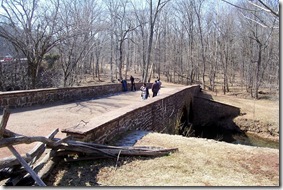 By 7:30 Evans deduced that Tyler had no intention of attacking across the Stone Bridge or any location below it. Obviously this was only a demonstration, and that could mean just one thing. Tyler wanted to keep him here and divert his attention from something else. Soon thereafter Evans discovered what that was, as a report came in that the Federal troops were to his left heading toward and even crossing Sudley Ford, northwest of his position.
By 7:30 Evans deduced that Tyler had no intention of attacking across the Stone Bridge or any location below it. Obviously this was only a demonstration, and that could mean just one thing. Tyler wanted to keep him here and divert his attention from something else. Soon thereafter Evans discovered what that was, as a report came in that the Federal troops were to his left heading toward and even crossing Sudley Ford, northwest of his position.
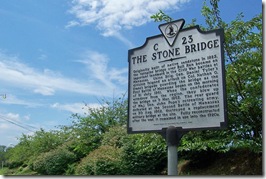 The Stone Bridge stands as a significant landmark in both battles that would occur in Manassas and along Bull Run in 1861 and 1862. This marker replaces a 1930's era marker that had shorter text: "The old stone bridge, just to the north, played a part in the battles of Manassas. Here rested the Confederate left in the early morning of July 21, 1961. Over the bridge Pope's retreating army passed, August 30, 1862." Historical Marker Database has a a photo of the old 1930's marker.
The Stone Bridge stands as a significant landmark in both battles that would occur in Manassas and along Bull Run in 1861 and 1862. This marker replaces a 1930's era marker that had shorter text: "The old stone bridge, just to the north, played a part in the battles of Manassas. Here rested the Confederate left in the early morning of July 21, 1961. Over the bridge Pope's retreating army passed, August 30, 1862." Historical Marker Database has a a photo of the old 1930's marker.
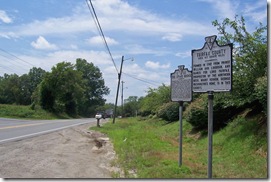
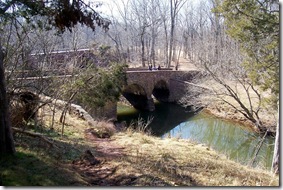
No comments:
Post a Comment